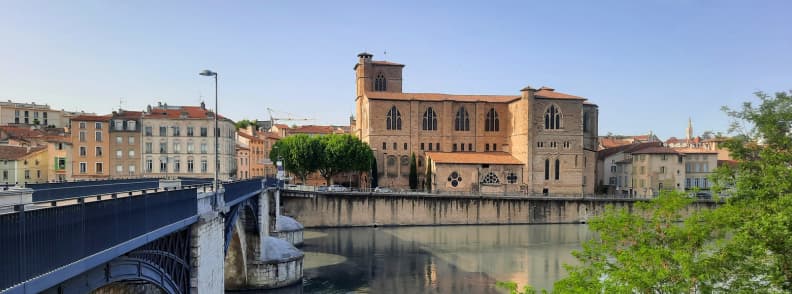I planned a surprise birthday trip for my husband, Mathieu, a whisky lover, and I wanted a base that felt smart, local, and easy to enjoy on foot.
If you visit Romans-sur-Isère for a quick escape or a full Romans-sur-Isère weekend, you want culture you can taste, walks that actually go somewhere, and prices that make sense.
From our home in the South of France near Bagnols-en-Forêt, I weighed Distillerie du Vercors vs Domaine des Hautes Glaces and then looked at where to sleep, where to eat, and what to do around each of them without a car once parked. Near the Vercors Distillery, Romans-sur-Isère had better-rated, better-priced accommodation and a compact center, so I chose it as our base.
Visit Romans-sur-Isère Guide
The Travel Bunny’s Romans-sur-Isère travel guide opens with our story and gives you a practical route through the city’s core strengths. You get industrial heritage that turned into a craft revival, Drôme gastronomy led by ravioles and pognes, and an identity built on footwear. This is the shoe capital of France, and you feel it in the streets, the museum, and the shop windows.
If you’re deciding on things to do Romans-sur-Isère, think in loops. Morning museum or riverside walk, lunch with ravioles, afternoon shopping or artisans, aperitif on a square. Everything sits close together, so you spend more time enjoying the city and less time crossing it.
See every spot mentioned here on my upcoming Romans-sur-Isère Rexby guide.
Disclosure: Some of the links below are affiliate links. This means that at no extra cost to you, The Travel Bunny will earn a small commission if you click through and make a purchase. Thank you!
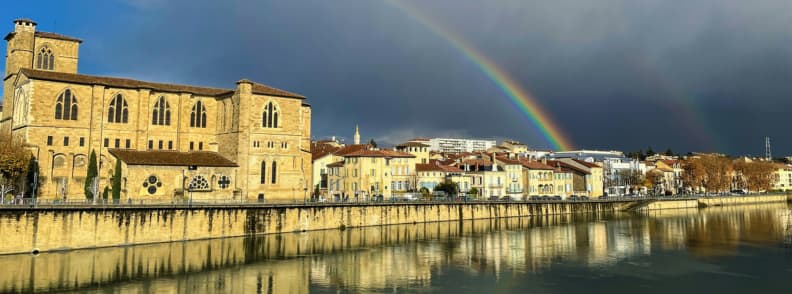
Why Visit Romans-sur-Isère?
Set between Vercors mountains and Rhône Valley, Romans-sur-Isère is both a cultural stop and a base for countryside exploration. The primary reason to visit Romans-sur-Isère is its blend of craftsmanship, gastronomy, and gentle local life. It’s a mix rarely found in such a compact, walkable city.
Quick Facts: Romans-sur-Isère is located in the Drôme department, southeastern France, with around 33,000 residents. It lies just 20 minutes from Valence TGV, connected by direct TER trains. The town sits along the Isère River, which separates the old historic quarter from the modern shopping area around Marques Avenue, one of the best outlet villages in the region.
Romans is best known as the shoe capital of France, home to the International Shoe Museum and the working ateliers of the Cité de la Chaussure, where heritage brands still create luxury footwear. It’s also the birthplace of the ravioles du Dauphiné and pogne de Romans, two culinary specialties that define Drôme’s identity.
Beyond its museums and food, Romans offers an atmosphere that feels distinctly French yet open to the world. The pace is unhurried, the architecture elegant but unpretentious, and locals are genuinely proud of their traditions. If you’re looking for a town that combines history, craftsmanship, and authenticity without crowds, Romans-sur-Isère is one of France’s best-kept secrets.
Drôme Travel Tip: Pair your visit to Romans-sur-Isère with a short stay in Valence or the Vercors Natural Park. You’ll experience both urban heritage and outdoor scenery within the same weekend.

Getting to Romans-sur-Isère from the South of France
We left Bagnols-en-Forêt on a Friday afternoon, snacks ready, and hit the A8 before merging onto the A7 toward the Drôme. The drive to Romans-sur-Isère takes around three and a half hours if traffic behaves. It’s a smooth highway ride most of the way, and we made our usual stop at a motorway aire for chips and cookies. That’s our road-trip ritual, the small pause that means we’ve officially started the weekend.
If you’re driving to Romans-sur-Isère, expect a relaxed route with several scenic stretches as you approach the Rhône Valley.
Romans is an easy weekend base once you understand the geography. The town sits between Valence and the Vercors foothills, close to the Isère River. There’s no TGV station in Romans itself, which surprises many visitors. The simplest way to reach Romans by train is to arrive at Valence TGV, then continue by TER or bus. The regional train takes about 20 minutes, and the bus lines from the TGV station to Romans-sur-Isère center run several times a day. Both options are inexpensive and straightforward, even with luggage.
If you’re planning how to get to Romans-sur-Isère from major cities like Paris or Marseille, the TGV is the fastest option. Paris to Valence TGV takes around two hours, and Marseille just over one. From there, your transfer to Romans feels quick. Travelers without a car can still explore the Drôme comfortably using local trains or buses, though renting a car gives you flexibility for day trips into the Vercors.
Driving in Romans-sur-Isère itself is manageable, and parking is rarely stressful. There’s free parking near Marques Avenue on weekends and several blue-zone areas closer to the center. Locals often park by the riverbanks or near the old Caserne Bon site for long visits.
Romans-sur-Isère Travel Tip: If you prefer to leave the car behind, Romans is compact enough to explore entirely on foot.
The BedinShop Concept & Our Stay in Romans-sur-Isère
If you’re wondering where to stay in Romans-sur-Isère that feels local and creative, BedinShop is the name to remember. Founded in 2019 by François-Xavier Chambost, this social-innovation company reimagined short-term rentals by turning vacant boutiques in the city’s historic centre into themed studios. Each apartment tells the story of a forgotten trade (bookseller, apothecary, shoemaker, tailor) and transforms Romans-sur-Isère’s old storefronts into livable pieces of heritage.
Where to stay in Romans-sur-Isère? For travelers and expats who want unique stays in Romans, BedinShop apartments are one of the most original concepts in southeast France.
The idea was simple yet powerful. Chambost wanted to breathe life back into Romans-sur-Isère’s fading commercial streets while contributing to the économie sociale et solidaire (ESS) or social and solidarity economy. Rather than let old boutiques decay, his team upcycled them into functional, eco-friendly lodgings that celebrate local craftsmanship.
Much of the furniture is handmade by local youth from recycled pallet wood, and the rest comes from regional reuse channels, giving each BedinShop unit a distinct, sustainable identity.
The concept bridges tourism and community revival. BedinShop welcomes both leisure and business travelers while actively supporting Romans’ downtown regeneration. When you stay here, you literally sleep inside a shop, a space that once sold goods, now offering you an authentic piece of the city’s story. Each apartment still displays its original façade, and inside you’ll often find local products for sale, from honey and herbal teas to small crafts. Guests are free to buy them and take a slice of Romans-sur-Isère home.
BedinShop’s mission goes beyond accommodation. It’s a model of circular economy and cultural preservation that links hospitality to heritage. When you book a room, you take part in a project that sustains artisans, promotes reuse, and revitalizes the old heart of Romans-sur-Isère. It’s one of the most original and meaningful unique stays in southeastern France, proving that travel can be stylish, responsible, and rooted in place all at once.
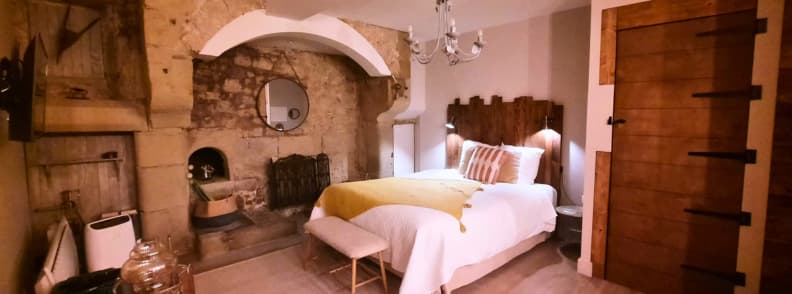
La Chaumière, Our Apartment in the Center of Romans
I initially had my eye on Le Bouquiniste, the bookshop-themed apartment, but it was very big for our needs. So I chose La Chaumière instead, and it turned out to be exactly what we needed for our short Romans-sur-Isère weekend trip. Tucked inside an 18th-century building once used by the drapers’ guild of Romans, the apartment still hides traces of the past. It has a massive stone fireplace, an old bread oven, and thick walls that seem to hum with local history.
La Chaumière felt instantly warm and intimate, like staying inside a countryside cottage reimagined for city life. The décor celebrates upcycling and reuse at every turn. The living-room table was once a baker’s dough trough from Ardèche, the kitchen shelves are old wine crates, and the copper pot once held jam. Even the bedside chandelier came from Emmaüs, and the small stove below the TV was rescued from La Ressourcerie Verte. In the shower, wooden shoe shapes have been reborn as towel racks, a clever nod to Romans’ shoemaking heritage.

Every piece of furniture has a story, and many were built by local youth from recycled pallets in partnership with the city’s social programs. They crafted the kitchen doors, the bench, the headboard, and even the sliding wooden door, all by hand. Staying here means supporting that work and helping to revitalize Romans’ historic center.
The apartment is designed for two, with a queen-size bed, a modern kitchen (microwave, fridge, induction hobs, coffee machine with capsules, and tea), and a bright bathroom with a hair dryer and ironing kit. Free fiber internet and HD television keep things practical, while free public parking sits a short six-minute walk away.

In one of the old wine boxes in the kitchen area, you have the Boutik. There, local products are displayed for guests to purchase, all sourced from nearby producers. It’s a thoughtful touch that links visitors directly to Romans’ artisans and makers.
We arrived late on Friday evening after driving up from the South of France, and check-in couldn’t have been easier. BedinShop uses a self-check-in system with a secure key box, so you can settle in at any hour without worrying about hosts or schedules. That flexibility makes a big difference when you’re coming from afar or fighting weekend traffic.
La Chaumière is one of those rare places that gets everything right: location, comfort, ethics, and story. It’s central yet quiet, full of heart and history, and proof that sustainable tourism in Romans-sur-Isère can be as inviting as it is responsible.
If you’re planning a weekend in Romans-sur-Isère and want an experience that blends comfort with conscience, book La Chaumière, the apartment where our own story began. You’ll wake up surrounded by history, creativity, and the satisfaction of knowing your trip leaves something good behind.
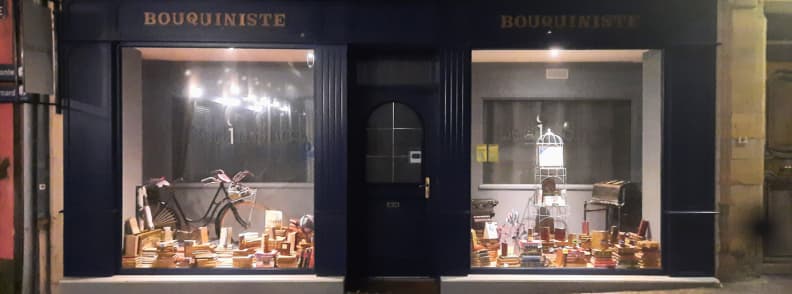
The Other BedinShop Apartments in Romans-sur-Isère
Le Bouquiniste is one of the most beloved BedinShop addresses. Once an old shop, it’s now a full apartment-hotel that feels like stepping straight into a 19th-century bookseller’s world. The shelves are lined with reclaimed wood and stacked with vintage volumes, literary curiosities, and small objects celebrating imagination and print culture. Soft lighting and calm corners make it feel like a private library frozen in time.
Le Bouquiniste apartment has two bedrooms, one bathroom, and comfortably hosts up to five guests. Couples love the atmosphere and location, while families or small groups can spread out without losing that sense of intimacy. Every piece of furniture reflects the BedinShop philosophy of reuse and community craftsmanship. Local youth built the living room table, the headboards, and the sliding door for the main bedroom from recycled pallets, giving the space an artisanal touch that ties it back to Romans itself.
If you love reading, and art, book Le Bouquiniste Romans-sur-Isère. You’ll be living inside its story, surrounded by the poetry of a town that knows how to reinvent itself.
La Lavandière is a peaceful, light-filled apartment inspired by the spirit of old Provençal washhouses and the women who once gathered there to scrub linen by hand. The small 18th-century boutique has been lovingly transformed into an eco-friendly studio that celebrates the art of simplicity. The décor mixes lilac tones, soft linens, and upcycled wooden pieces, creating the calm of a countryside home right in the centre of Romans-sur-Isère.
Beyond color and style, La Lavandière tells a story. The apartment pays tribute to the lavandières of the 19th century, those who worked at the river’s edge surrounded by soap, bubbles, and laughter. Today, you sleep inside that world, surrounded by echoes of their craft. The living-room table and the headboard were built by local youth from recycled pallets, part of BedinShop’s partnership with community programs that teach sustainable design and practical skills.
La Lavandière can host up to four guests, with one queen-size bed and a comfortable sofa bed, making it ideal for couples, small families, or digital nomads looking for a serene base. It includes a modern bathroom, a small self-catering kitchen with an induction stove, microwave, fridge, and coffee machine with capsules and tea, plus fiber internet and HD television. The winter garden adds an extra corner for reading or morning coffee, a small luxury that’s rare in city apartments.
If you want to experience southern French aesthetics without leaving the city, book La Lavandière Romans-sur-Isère. Staying here is a small gesture toward sustainability, local youth employment, and the revival of the historic core of Romans-sur-Isère.
L’Apothicaire is the boldest and most striking of the BedinShop apartments, a place where vintage charm meets industrial design. This shop in the center of Romans-sur-Isère has been reimagined as an eco-friendly and socially conscious stay that captures the spirit of an old-world apothecary. Metal fixtures, exposed brick walls, and glass shelving echo the feel of a traditional pharmacy, while warm lighting and upcycled details soften the space and make it inviting.
The L’Apothicaire apartment comfortably hosts up to four guests, with two bedrooms (one with a double bed and another with two single beds). The modern bathroom features a walk-in Italian shower, and the fully equipped kitchen includes a refrigerator, induction hob, microwave, and all the essentials for self-catering.
L’Apothicaire apartment stands out for its aesthetic precision and atmosphere. Every object feels curated, every material tells a story, and yet the layout still respects the original shape of the boutique it once was.
Book L’Apothicaire Romans-sur-Isère. It’s perfect for design lovers, small families, or travelers looking for an inspired alternative to a standard hotel.
Le Tailleur is an elegant nod to the craftsmanship that once defined Romans-sur-Isère’s city center. This BedinShop apartment recreates the atmosphere of a classic tailor’s workshop, complete with vintage tools, sturdy textiles, and a design aesthetic that feels timeless. It’s one of the most refined hébergements insolites in town, and especially fitting if, like me, your family name happens to be Letailleur.
The Le Tailleur apartment features two bedrooms (one double bed, two singles), a modern bathroom with Italian shower, and a fully equipped kitchen complete with refrigerator, induction hob, microwave, and Nespresso coffee maker.
If you appreciate fine details and the art of craftsmanship, book Le Tailleur Romans-sur-Isère. You’ll be sleeping inside a story stitched with meaning and local pride.
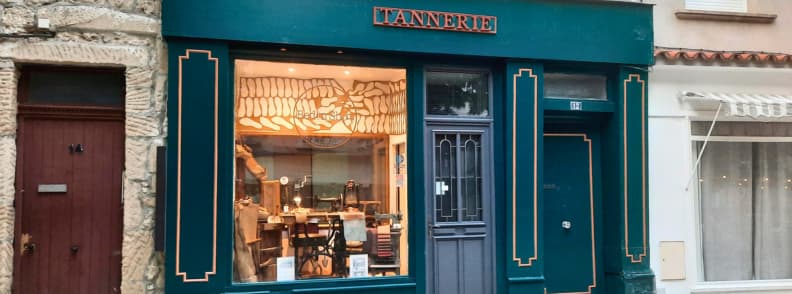
La Tannerie is one of BedinShop’s most collaborative projects. Designed around Romans’ shoemaking heritage, it revives the world of traditional tanneries and the artisans who worked them. The décor combines objects on loan from the Musée International de la Chaussure with handcrafted furniture built by local youth in partnership with the city’s specialized prevention service.
The result is a warm and textured interior filled with nods to craftsmanship, such as reclaimed leather details, industrial accents, and repurposed wood. The apartment features one bedroom with a queen-size bed, a comfortable sofa bed, and a bright bathroom. A compact kitchen with a microwave, fridge, induction plates, and coffee machine makes self-catering easy.
If you’re drawn to the city’s shoemaking legacy, book La Tannerie Romans-sur-Isère and sleep surrounded by its story. Part museum, part home, all heart.
Le Grand Café des Cordeliers revives the spirit of the café that once stood on this very spot. Closed in 1985, it’s now reborn as a unique apartment blending memory and design. The original café counter has been transformed into a kitchen island, and several decorative pieces come directly from the old establishment. It’s an invitation to relive the golden age of Romans’ social life through carefully preserved details and a warm, convivial layout.
The apartment includes two bedrooms (one double bed, two singles), a stylish bathroom with Italian shower, and a fully equipped kitchen for easy self-catering. Guests have free Wi-Fi, TV, coffee capsules, and linens provided.
Like all BedinShop properties, Le Grand Café is part of a sustainable hospitality project that reinvests in Romans’ heritage. A portion of its income supports 1% for the Planet, making your stay both meaningful and responsible.
If you love design with a story, book Le Grand Café Romans-sur-Isère. It’s a place where espresso cups, laughter, and history linger in the walls.
Each BedinShop apartment carries the same DNA: reuse, creativity, and connection to Romans’ past. These places to sleep in Romans-sur-Isère are part of a local movement to give old streets a second life. Every booking supports local youth programs, artisans, and the ongoing revitalization of the city’s historic heart.

First Evening Walk in Romans-sur-Isère. Music, Wine & River Light
Our first night in Romans-sur-Isère began with the easy comfort of arriving late, dropping our bags, and heading straight out for dinner. The street was silent except for the soft hum of conversation coming from Le Maquisart, the restaurant just across the street from our BedinShop apartment. It used to be one of those rare places that blended everything. They had nice music, good food, and genuine atmosphere.
We ordered burgers and a bottle of Enfant Terrible, a lively Côtes-du-Rhône recommended by the waiter. It turned out to be one of those spontaneous meals that makes you feel instantly part of the city. The team behind Le Maquisart also ran Disqu’art, a vinyl shop next door. The two locations created an authentic, vintage mood that became part of Romans’ identity. Sadly, Le Maquisart has now closed, but its spirit still lingers in the way Romans enjoys its evenings, with a mix of music, food, and friendship.
If you’re wondering where to eat in Romans-sur-Isère for a Friday evening with atmosphere, two excellent alternatives capture that same energy. For burger lovers, Romans Burger (Panzo) is the top local choice. Created by chef Matthieu Prandi, a Maître Restaurateur since 2023 (the only state-certified label that guarantees fresh, local, fully homemade cuisine), this restaurant started as a gourmet food truck before settling permanently on Place Puits du Cheval. The menu celebrates local ingredients, seasonal produce, and creative takes on street food that respect French culinary standards. It’s easily one of the best restaurants in Romans-sur-Isère for a casual yet exceptional dinner.
If you’d rather taste something local, head to La Raviolista, Romans’ best bar à ravioles. The menu is built around the region’s signature ravioles du Dauphiné, served in endless variations. They can be baked, in broth, with salad, or dressed with herbs and cheese. Whether you’re after a quick bite or a comforting dinner, it’s an ideal introduction to Romans’ food culture. Every dish celebrates the local ingredients that make Drôme’s cuisine so beloved.
After dinner, we took a walk along the Isère River, the lights flickering on the water and the air still warm from the day. The path led past sculptures of shoes scattered through the streets, part of the city’s tribute to its leather-making and footwear history. Seeing them at night, half-lit under the street lamps, gave them a curious life of their own, like a small reminder that Romans is a city where craftsmanship and creativity never fully go to sleep.
If you’re looking for things to do at night in Romans-sur-Isère, don’t rush. The best moments here are unhurried. Enjoy a glass of local wine, a riverside stroll, and a chat with the bartender about a new vintage.
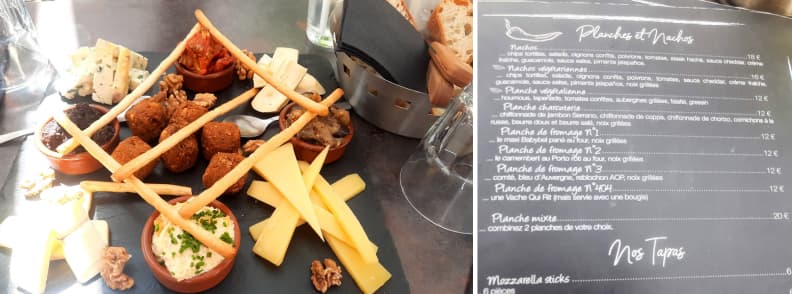
Breakfast at L’Atelier du Jus
Late morning in Romans, we left La Chaumière and went looking for something more substantial than a croissant. Most cafés were already shifting to lunch, and Romans isn’t exactly a breakfast town unless it’s Sunday brunch. Still, L’Atelier du Jus had its doors open and sunlight spilling onto the terrace, and they were nice enough to put together a planche mix of local cheeses, dips, and small bites for us.
It wasn’t the classic breakfast we expected, but it was perfect. The plate came piled with cheese, walnut halves scattered between small bowls of tapenade, roasted vegetables, and creamy spreads. There were falafel bites, crisp breadsticks, and fresh slices of baguette in a metal basket. The flavours were honest, local, simple, and filling. It was exactly what we needed before driving into the Vercors.
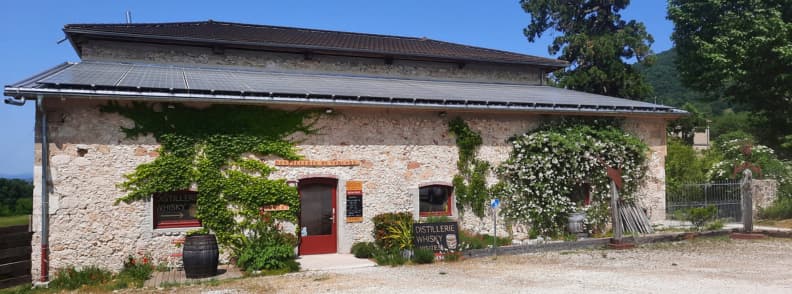
Our Visit to the Distillerie du Vercors
The highlight of our weekend and the reason for the entire trip was visiting the Distillerie du Vercors, a small organic whisky distillery in the foothills of the Vercors mountains. It sits in Saint-Jean-en-Royans, just a 35-minute drive from Romans-sur-Isère. The drive to get to the distillery is part of the pleasure, with winding roads, mountain views, and that calm sense of entering another rhythm entirely. The distillery occupies an old silk farm that has been eco-renovated into a space of innovation and craft.
A Private Tour with a Passionate Maker
The tour was led by the owner himself, and we happened to be the only visitors that morning, so it turned into a private experience. He welcomed us warmly, explaining how Distillerie du Vercors began as a personal experiment in slow distillation, a method designed to reduce energy use while enhancing flavor. Instead of heating the mash quickly, he designed a custom copper still that distills at a much lower temperature, lowering the carbon footprint and preserving delicate aromas. The result is a whisky that’s as thoughtful as it is smooth.
How Sequoia Whisky Is Made
Distillerie du Vercors produces whisky the slow way, deliberately, with an attention to detail that most distilleries can’t afford. Every bottle of Sequoia Whisky begins with one organic barley certified AB (agriculture biologique) grown in France. Some of it is grown on the fields surrounding the distillery.
Eric Cordelle, the founder and distiller, chose barley for tradition and for its rich aromatic palette, capable of expressing the land as clearly as wine does. The barley is then malted in nearby Ardèche by Malteurs Echos, a small malting house that shares the same commitment to organic, sustainable farming.
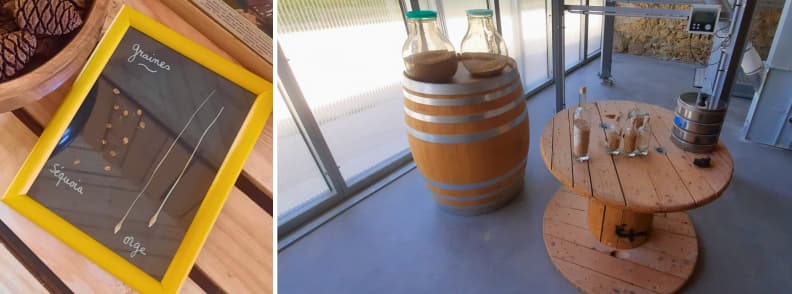
Once the grain returns to Saint-Jean-en-Royans, it’s crushed into grist and mixed with pure spring water that flows directly from the Vercors mountains, one of the reasons the distillery stands here in the first place. The crystal-clear water is heated before being poured into the mash tun, where it awakens the barley’s natural enzymes. These enzymes convert starch into fermentable sugars, creating a sweet liquid called wort.
What remains never goes to waste. The spent grain, known here as drèche, gets sent to the dairy farm next door, where it helps feed the cows that produce some of the region’s best cheese.
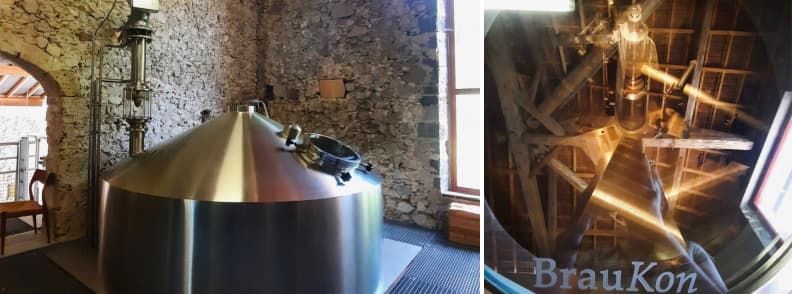
Fermentation lasts around four days. It’s the longest stage of the process and one that fills the old silk farm with the smell of warm, malty beer. During this time, natural yeasts transform sugar into alcohol, producing a lightly alcoholic wash of about 7-8% ABV. The temperature is carefully monitored to stay below 30°C, protecting the delicate aromas.
Then comes the two-step distillation system. The first distillation takes place in an innovative stainless-steel still named Nautilus, custom-engineered to operate at an extremely low temperature of around 50°C. By adjusting internal pressure, the distiller can lower the boiling point of alcohol, a technique inspired by both science, perfume-making, and slow cooking.
Low-heat distillation is what makes Distillerie du Vercors one of a kind. The lower heat preserves the grain’s natural aromas, creating a round, floral, and balanced spirit. And it consumes less energy, making the process significantly more eco-friendly.

This first distillation yields a gentle spirit of about 25% ABV. It then passes into a traditional copper still for a second, more precise distillation at a higher temperature in the Belle alambic. This step purifies the spirit and allows for the crucial “cut” that separates heads, hearts, and tails to isolate the perfect core. Only the coeur de chauffe, the heart of the distillate, is selected and transferred into barrels at around 65% ABV.
Maturation takes time. It lasts at least three years, sometimes ten or more. The whisky rests in a mix of new French oak barrels and older “roux” barrels that once held wine or cognac. Each type brings its own voice. There’s vanilla and spice from the new wood, or fruit and honey from the reused casks. The natural climate of the Vercors, cool and steady, slows down evaporation and deepens flavor development.
Once the barrels have finished their work, they’re passed on to the neighboring local brewery. The cycle is simple, sustainable, and deeply local. It’s exactly what makes this place stand out among organic whisky producers in France.
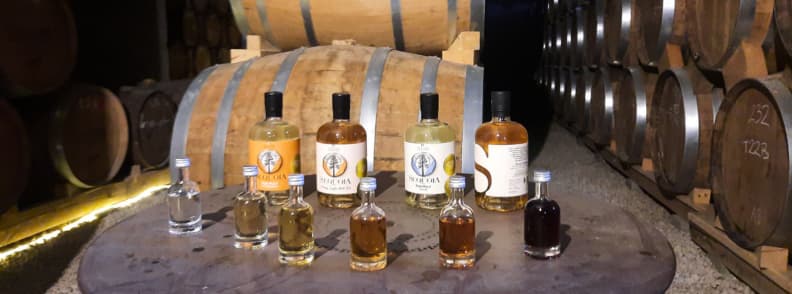
When the whisky is finally ready, it’s bottled and labeled by hand on site, unfiltered and free of artificial coloring. Every shade of gold in Sequoia Whisky comes purely from the oak that shaped it, with nothing added, and nothing masked.
Sustainability is part of the distillery’s core values. Renewable energy from solar panels powers the production, cooling water is recycled, and the entire cycle from grain to glass is designed to minimize waste. The resulting organic whisky makes a statement about what modern French craftsmanship can be when heritage meets environmental respect.
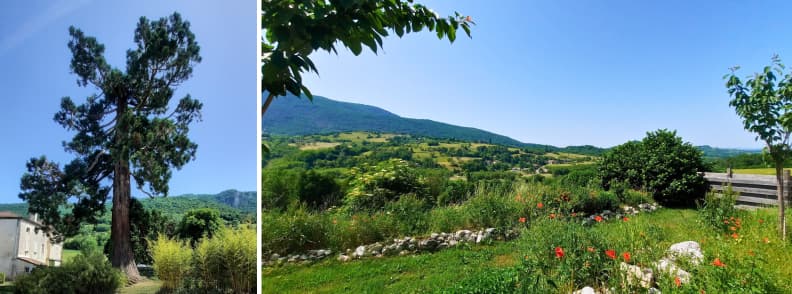
From the Sequoia Tree to the Bottle
The distillery’s signature bottles, Sequoia Whisky, take their name from a solitary sequoia tree that stands beside the building. It’s an unlikely sight in rural Drôme, tall against the mountains, and now a symbol of patience and longevity. During the visit, we stepped inside the barrel room, where the air was rich with the scent of oak and grain. The owner showed us the difference between their regular whisky and the peated one, comparing their colors in the low light.

Award-Winning Craftsmanship
Over the years, Distillerie du Vercors has won several prizes for its innovation and craftsmanship, not only for the taste of its whisky but also for its ecological production. The slow-distilling technique, the locally sourced barley, and the low-temperature process make it one of the most respected names in organic whisky in France.
At the end of the visit came the tasting. My husband chose the Sequoia tourbé, smoky and elegant, and I added two tulip glasses to his birthday gift. It felt like the perfect souvenir from this trip, because he enjoys sharing and talking about whisky with his friends whenever they come to visit.
Planning Your Visit to the Distillerie du Vercors
A visit to the Distillerie du Vercors is one of the best Vercors day trips from Romans-sur-Isère. You can book a guided whisky tour in Vercors directly on their website or stop by the boutique to taste and buy Sequoia whisky. The team speaks English and French, and tours run several times a week. For travelers without a car, consider renting one in Romans or Valence. The countryside roads are easy and scenic, and you shouldn’t miss out on this experience.
Rent a car from Valence or Romans to visit the Distillerie du Vercors
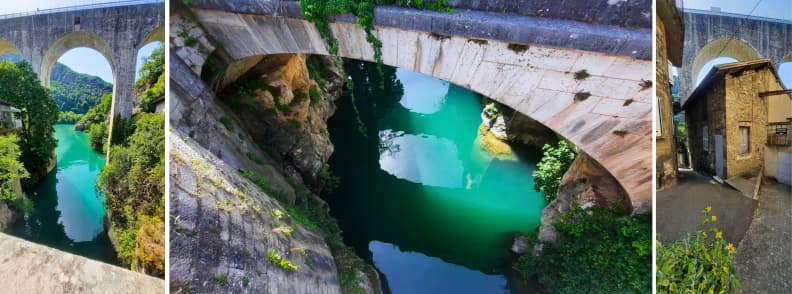
Stop at Saint-Nazaire-en-Royans & its Aqueduct over the Isère
On the way to the distillery, we didn’t have time to stop. We were watching the clock for our reserved visit slot at the Distillerie du Vercors. But on the way back, the pace changed completely. We pulled over at Saint-Nazaire-en-Royans, a small village perched between river and rock, and the perfect scenic pause between the Vercors mountains and Romans-sur-Isère.
The highlight here is the Aqueduc de Saint-Nazaire-en-Royans, a graceful bridge of stone arches crossing the turquoise waters below. Built in the nineteenth century to bring drinking water from the Vercors, it’s now one of the most photogenic stops in the region. You can admire it from the road, walk underneath along the Isère River, or climb up for panoramic views of the valley.
We found a terrace next to the road, where we had iced tea and some ice cream with a view. The spot belongs to the Hotel-Restaurant across the street, which also has another terrace reserved for diners with an even better view of the aqueduct. Even without a meal, the casual riverside café area is a peaceful break, especially in warm weather.
Saint-Nazaire-en-Royans is known as one of the gateways to the Vercors, and it perfectly captures the area’s rhythm. It’s relaxed, scenic, and deeply tied to nature. This is an easy half-hour stop between Romans and the mountains, ideal for stretching your legs and taking photos before heading back into town.
Vercors Local Tip: Park just before the bridge and walk five minutes to the riverbank for the best photo of the aqueduct’s reflection in the water.
Romans-sur-Isère’s Ravioles, Pogne & Drôme Flavours
Romans-sur-Isère is where food becomes local identity. You can taste the region’s soul in its simplest dishes (ravioles, pogne, Picodon cheese), each rooted in the surrounding Drôme countryside. Locals are proud of this culinary heritage, and it shows in the way restaurants, bakeries, and markets champion local producers.

The Cité de la Raviole
We spent part of the afternoon at La Cité de la Raviole. Opened in 2020 by the historic Maison Mère Maury, this small museum-shop celebrates the story of the ravioles du Dauphiné, delicate squares of fresh pasta traditionally filled with Comté cheese, crème fraîche, and parsley. What began as a humble dish for sixteenth-century Italian woodcutters working in the Vercors has become a protected regional treasure with an IGP (Indication Géographique Protégée) label and its own annual festival.
Inside the museum, you walk through five centuries of culinary evolution. Displays explain how those early workers adapted their native ravioli recipe to local French ingredients, using soft wheat and fresh cheese. By the nineteenth century, the modern version of ravioles was born. They are small, paper-thin, and filled with a creamy mixture. They soon became a festive dish served at family gatherings.
The museum also highlights the role of the ravioleuses, the women who once traveled from farm to farm before major holidays to prepare ravioles by hand. Their craft nearly disappeared during World War I, but cafés like Mère Maury’s kept the dish alive, turning it into a local tradition.
By the late twentieth century, ravioles had gained fame across France. The AOC Raviole du Dauphiné appeared in 1989, followed by the Label Rouge in 1998 and the IGP in 2009, which defined the official production zone of 74 communes around Romans. Today, top chefs such as Anne-Sophie Pic and Cyril Lignac have elevated ravioles from comfort food to gastronomy, creating versions with truffles or foie gras.
The Confrérie de la Raviole du Dauphiné, founded in 2003, preserves the original recipe and promotes it through events and festivals. The most famous is the Fête de la Pogne et de la Raviole, held each June in the heart of Romans-sur-Isère. These are two days of joy, food stalls, and local pride. Every participating bakery and restaurant serves its own signature version, and the smell of butter and cheese fills the air.
At the end of our visit, we hoped to bring some trays home, but we didn’t have a cooler bag, and their fresh ravioles must stay chilled. But they can be bought all over France, and the staff were nice to explain the best cooking method. You poach for one minute in salted water, no more, then toss with butter or cream.
Romans-sur-Isère Foodie Tip: The Cité de la Raviole shop sells local condiments, pasta tools, and sauces, perfect for travelers and expats who want to recreate Drôme flavours back home. If you visit in June, plan to stay for the Fête de la Pogne et de la Raviole. It’s the best time to experience Romans’ food heritage come alive in the streets.
Local Food You Can’t Miss in Romans-sur-Isère
Ravioles are just the start. Romans is also known for its pogne de Romans, a sweet, buttery brioche perfumed with orange blossom water. It dates back to the Middle Ages and was once baked for Easter celebrations. Today, you’ll find it in every bakery window and even in supermarkets.
The best-known producers are Maison Pascalis and Pognes Mourier, both of which keep the original recipe alive. A slice of pogne with morning coffee is one of those small local luxuries that make Romans memorable.
Beyond ravioles and pogne, menus across the city highlight Picodon goat cheese, Caillette (a type of herb-laced meatball), and Saint-Marcellin, a creamy cheese from the nearby Isère valley. Romans-sur-Isère’s Saturday and Sunday markets on Place Maurice Faure are the best places to taste these products fresh and meet the producers directly.

Walking Through Romans. Fountains, History & the Oldest Streets
Exploring Romans-sur-Isère on foot is the best way to see it. The town isn’t large, but every street carries traces of its layered past. We started by looking for the oldest house in Romans-sur-Isère, tucked among narrow lanes where faded signs still mark the workshops of old artisans. The stone façades and painted shutters have that lived-in beauty typical of small French towns.
Crossing the centre, we reached Place du Champ-de-Mars, Romans-sur-Isère’s most open and lively square. Children were splashing in the fountains, families sat in the shade, and the Monument aux Morts stood silently nearby. The air smelled faintly of grass and summer heat. It’s the kind of place where you stop without planning to, just to watch local life unfold.
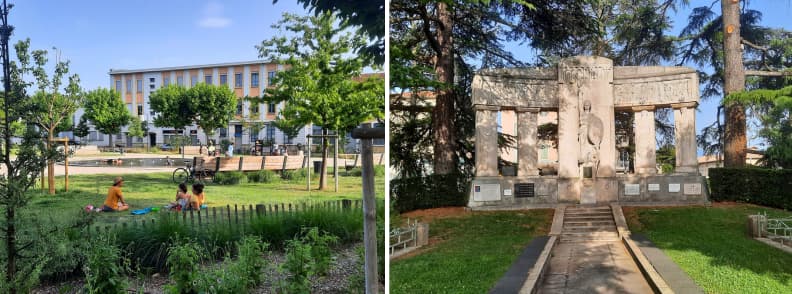
We wandered next to Place Jules Nadi, one of my favourite corners in town, framed by pastel houses and a small gazebo that looks like it belongs in a storybook. The cafés nearby were filling with evening chatter, the kind that signals the start of a relaxed Saturday night.
From there, we followed the streets downhill toward the river and the Collégiale Saint-Barnard, the great stone church overlooking the Isère. Its towers caught the last light of the day, golden against the water. The walk might only take thirty minutes end to end, but in Romans, time stretches and every turn gives you another reason to pause.
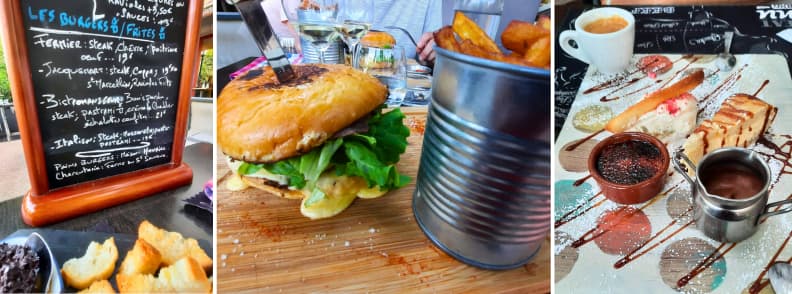
Saturday Dinner in Romans-sur-Isère
Our dinner that night was at Le BistRomansgeur, a cheerful spot that has since closed, but it embodied what Romans dining is all about: local, seasonal, and personal. The owner (who was also handling our table that evening) could trace every ingredient back to its source, even the potatoes from his father’s garden. That attitude lives on in places like Le Dandy and La Villa Margot, two of the city’s best current restaurants that carry on the same love for fresh, regional food.
Le Dandy sits right on Place Maurice Faure, a square layered with nearly a thousand years of history. The restaurant’s warm, slightly bohemian interior matches its philosophy of family-style cooking rooted in local produce. Every dish is made from scratch, using seasonal ingredients sourced from nearby farms and artisans. The menu changes daily depending on the chef’s inspiration and what’s freshest at the market. The covered terrace catches the sun just right, making it a favourite for a leisurely lunch or an unhurried dinner where you can watch Romans go by.
Across town, opposite Marques Avenue, La Villa Margot brings a touch of refinement to Romans-sur-Isère’s food scene. Set inside a nineteenth-century bourgeois house surrounded by trees, it blends elegance with local authenticity. The cuisine is gourmet but grounded, with creative dishes built from fresh, local, and often organic produce, sourced directly from French farmers, cheesemakers, and artisans. The team champions the “art of good taste”, pairing culinary craftsmanship with environmental awareness. This means short supply chains, composting, selective recycling, and minimal waste. The result is a meal that feels both indulgent and responsible, which fits Romans’ new wave of sustainable gastronomy.
Romans-sur-Isère Foodie Travel Tip: For a perfect food day in Romans, have lunch at Le Dandy for its relaxed local vibe, then book dinner at La Villa Margot for an elegant finish surrounded by the charm of its private park.
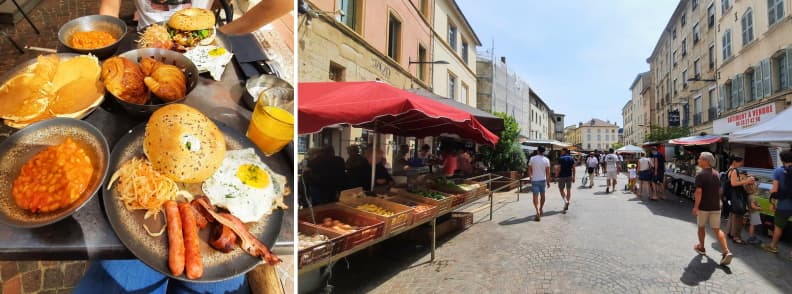
Sunday in Romans. Brunch & Market Life
Sundays in Romans-sur-Isère are slow, sociable, and full of flavour. The air smells like fresh herbs and roasted chicken, and the chatter of vendors fills the squares.
Brunch at Le Jakadi
We started our morning at Le Jakadi, a local favourite for brunch, right on Place Maurice Faure. We had seen their brunch advertised on their walls, and we had been dreaming of a good brunch ever since we moved to the South of France. There aren’t many brunch opportunities where we live, and we really appreciated the one at Le Jakadi. It’s friendly, unpretentious, and generous with its portions. It’s exactly the kind of place where locals linger over coffee long after finishing their croissants. Which is why you have to book in advance!
The Sunday Market
From there, we wandered into the Sunday market, one of the liveliest in the Drôme. It stretches from the church down to Place Maurice Faure, where stalls overflow with local cheeses, seasonal vegetables, fresh herbs, olives, and bottles of Côtes du Rhône wine.
The best time to go is around 10 AM, when the city is fully awake but before the lunch rush. This is when you can chat with producers about their Picodon goat cheese, taste slices of pogne brioche, or watch shoppers fill woven baskets with produce still damp from the fields.
Romans’ markets feel different from those in bigger cities. It’s smaller, more intimate, and more grounded in daily life. For expats living nearby, it’s a perfect place to practice French, pick up local cooking tips, and become part of the weekend routine.
Visit Romans-sur-Isère Tip: Visit the market early, have brunch at Le Jakadi, then circle back around noon to grab a bottle of local wine and some pogne for the road. It’s the best way to leave Romans. You’ll be full, relaxed, and already planning your return, just like we did!

Visiting Romans-sur-Isère, The Shoe Capital of France
Romans-sur-Isère built its reputation one step at a time. Literally.
Known as the shoe capital of France, Romans-sur-Isère has shaped centuries of craftsmanship, design, and industry. From workshops crafting royal slippers to modern designers reinventing sustainable footwear, Romans’ shoe brands reflect both heritage and innovation. Mathieu’s grandfather used to buy shoes here, part of a long line of customers drawn to the city’s impeccable quality. Today, the legacy continues through museums, artisan workshops, and contemporary outlets that bridge the past and present.
The International Shoe Museum. Visiting the Former Convent
Musée de la Chaussure or the International Shoe Museum in Romans-sur-Isère is where the city’s story begins. Housed in the former Convent of the Visitation on Rue Bistour, this landmark traces 4,000 years of shoe history, from Egyptian sandals to 18th-century silk slippers and modern runway designs. The museum holds an extraordinary collection of 16,000 pairs, including pieces from Christian Dior, Salvatore Ferragamo, and André Perugia, and other masters whose names built Romans’ global reputation.
The setting adds another layer to your visit. You’ll see stone cloisters, vaulted ceilings, and courtyards where craftsmanship meets architecture. Each gallery explores a different chapter, covering ancient civilizations, royal courts, industrial production, and contemporary innovation. Special exhibits often highlight local designers who worked in the area’s famous factories before the decline of large-scale shoemaking in the late twentieth century.
The International Shoe Museum is open Tuesday to Sunday, 10 AM to 6 PM, and is free on the first Sunday of every month, making it one of the most accessible cultural sites in the Drôme. Even if you only have a few hours, it’s worth visiting to understand how this town once supplied shoes to queens, celebrities, and designers worldwide.
We didn’t have time to visit the museum on this trip, but it’s first on my list for next time. Seeing the craft that once drew Mathieu’s grandfather here would close the circle beautifully, from heritage to memory, from family to tradition.
Romans-sur-Isère Itinerary Tip: Pair the museum with a visit to the nearby Cité de la Chaussure, where you can watch artisans at work and buy shoes made entirely in Romans. The walk between the International Shoe Museum and the Cité de la Chaussure takes under ten minutes, making it an easy cultural loop through the city’s creative heart.
La Cité de la Chaussure
Just a short walk away, La Cité de la Chaussure carries this legacy forward into the present. This creative hub brings together master artisans and historic brands such as Robert Clergerie, Charles Jourdan, and J.M. Weston, all of which have deep roots in Romans. Visitors can watch shoemakers at work, see limited-edition collections come to life, and even purchase handmade shoes directly from the workshops. It’s part heritage site, part living atelier, where the sound of leather cutting still fills the air.
The Cité de la Chaussure also acts as an incubator for emerging designers, supporting innovation while keeping the city’s craft alive. What began as an industrial powerhouse has now transformed into a model of sustainable, small-scale production. Many of the shoe brands Romans nurtured decades ago, like Jourdan and Clergerie, remain global symbols of French elegance because of the city’s enduring know-how.
Marques Avenue Romans, the Shopping Destination
A few minutes from the historic centre, Marques Avenue Romans gives the city’s shoemaking heritage a modern twist. Located inside the former Caserne Bon, this outlet village gathers over 70 fashion and lifestyle brands, many linked to the local industry. For travelers looking to shop for quality French goods at lower prices, it’s the region’s biggest retail hub.
Shoppers praise the discounts and easy parking, and you can easily spend a morning browsing between cafés and boutiques. Most stores are open Monday to Saturday from 10 AM to 7 PM. Some visitors mention the compact layout and crowds on weekends, so arriving early offers a more comfortable experience.
Beyond shoes, Marques Avenue sells clothing, homeware, and accessories, but it remains the best place to find footwear tied to Romans’ legacy, both from heritage shoemakers and modern French labels.
Romans-sur-Isère Travel Tip: Bring comfortable shoes and plan a mid-morning stop. Combining Marques Avenue with lunch at La Villa Margot across the street makes a relaxed half-day itinerary.
Romans, Écrin des Métiers d’Art. Supporting Local Craft
While the outlets represent modern commerce, Romans-sur-Isère’s true soul still lives in its workshops. In the historic centre, nearly 70 artisans and artists keep the Made in Romans spirit alive from about 30 boutique-ateliers. Together they form Romans, Écrin des Métiers d’Art, a network that connects traditional craftsmanship (leather, ceramics, glass, textiles) with contemporary design.
Discovering these narrow streets feels like walking through an open studio. You might find a leatherworker restoring vintage Jourdan heels, a jeweller crafting pieces inspired by the Isère River, or a textile artist reusing materials once destined for factories. For expats and travelers interested in sustainable shopping, these ateliers offer authentic souvenirs made entirely in town.
Visit Romans-sur-Isère Tip: Visit during the spring or autumn open-studio weekends, when artisans host demonstrations and workshops. It’s a rare chance to see how Romans continues to reinvent its heritage through skill and creativity.
History & Architectural Heritage in Romans-sur-Isère
For travelers wondering what to visit in Romans, the old quarter on the right bank of the Isère is the place to go. Here you’ll find medieval churches, remnants of fortifications, and narrow streets that once sheltered artisans, merchants, and monks. If you’re looking for things to do in Romans beyond its museums and markets, this part of town offers a self-guided walk through a thousand years of architecture, faith, and civic life.
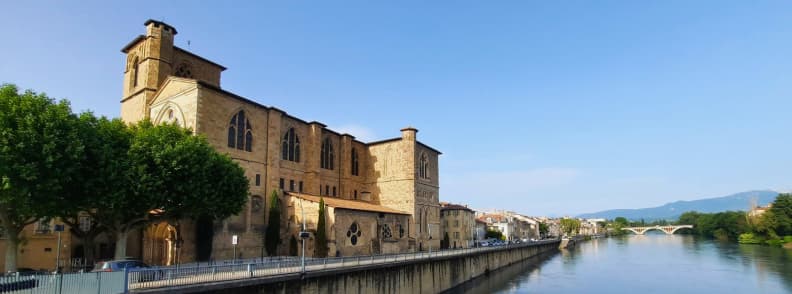
Collégiale Saint-Barnard, a Monumental History
The Collégiale Saint-Barnard is Romans’ spiritual and architectural heart. Founded in 837 by Archbishop Barnard of Vienne, the church stands on the same riverbank where the town itself was born. Its architecture tells the full story of Romans-sur-Isère, with Romanesque roots meeting Gothic ambition. The lower nave still carries the weight of early medieval stone, while the upper levels and transept rise light and intricate, their vaults soaring 24 metres above the floor.
Inside, the church holds several treasures that make it one of the most remarkable Romans-sur-Isère attractions. In the choir, 14th-century wall paintings inspired by Mediterranean art unfold in rich blues and ochres. In the Chapel of the Holy Sacrament, you’ll find the Mystery of the Passion, a sixteenth-century embroidered tapestry illustrating nine scenes from the life of Christ. It’s a rare survivor of Renaissance devotional art in France.
More recent but equally striking are the Apocalypse windows, designed in 2000 by German artist Georg Ettle in collaboration with the Thomas Vitraux studio. These colorful stained-glass panels reinterpret Saint John’s vision of the Apocalypse in modern colours and forms, linking centuries of spiritual imagination.
The Collégiale was devastated and rebuilt many times after wars, fires, and floods by locals to protect their heritage. It was officially listed as a Monument Historique in 1840, ensuring its preservation for future generations. Today, it remains a peaceful space for reflection, history, and art, a must-see for anyone exploring places to see in Romans.
Visit Romans sur Isère Tip: Visit late afternoon when sunlight floods the nave through the west windows. The mix of Romanesque stone and modern glass feels almost alive.
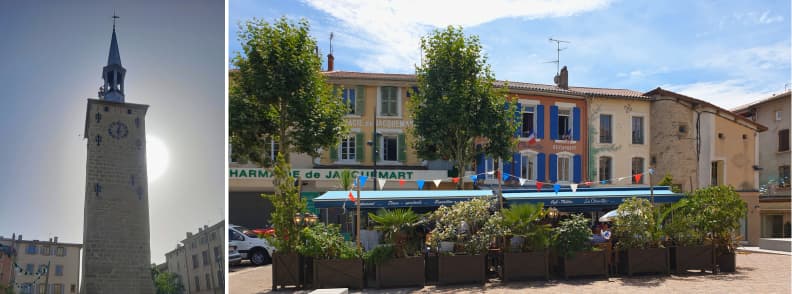
Walking the Medieval Remparts & Tour Jacquemart
Just beyond the church, the streets of old Romans-sur-Isère still follow the lines of its medieval ramparts, built in the 11th century to protect the growing town. While most of the walls have disappeared, one tower remains. It’s the Tour Jacquemart, a sturdy sentinel that once marked the town’s skyline. The tower still houses its famous automaton clock, Jacquemart, the metal figure who strikes the hours.
Walking these lanes gives a sense of continuity rarely found in modern towns. You pass the Couvent de la Visitation, now home to the International Shoe Museum, and the Maison du Mouton, one of the oldest houses in the city, known for its timber-framed façade. Together, they illustrate how Romans evolved from a religious settlement into a centre of trade and craftsmanship.
Romans-sur-Isère also played an unexpected role in national history. In 1349, the city hosted the transfer of the Dauphiné to France, marking its integration into the kingdom. Later, in 1788, it witnessed the final meeting of the Estates of Dauphiné, a political event that foreshadowed the French Revolution.
For visitors wondering what to see in Romans, this walk captures faith, artistry, politics, and resilience. These are the foundations of a city that has always known how to rebuild itself.
Romans-sur-Isère for Families, Couples & Solo Travelers
Romans-sur-Isère fits families looking for relaxed days, couples in search of culture and good food, and solo visitors who enjoy discovering local life at their own pace. The town’s scale makes it easy to navigate, while its variety of activities ensures there’s always something personal to take away. Here’s how to make the most of Romans, no matter how you travel.
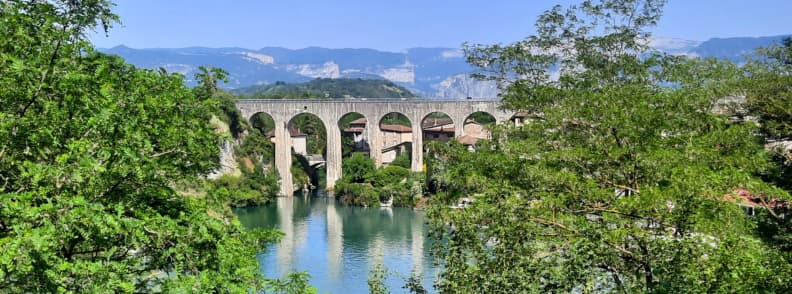
Romans-sur-Isère for Families. Easy Adventures & Local Markets
Families will find Romans-sur-Isère welcoming and manageable. The Sunday market on Place Maurice Faure is a perfect morning outing. It’s colorful, noisy, and full of local food to taste. Children love running through the fountains at Place du Champ-de-Mars, especially on warm days, while parents relax at nearby cafés. For something educational but fun, the Cité de la Raviole and Musée International de la Chaussure both have interactive exhibits suitable for kids.
Outdoor families can take short day trips to the Vercors foothills or Saint-Nazaire-en-Royans, where the aqueduct and river views make easy half-day excursions. Romans’ calm pace and flat streets also make it ideal for families with strollers or young children.
Romans-sur-Isère Family Tip: Stop by Maison Pascalis for a slice of pogne and let the kids choose their own pastry. Simple, local, and guaranteed smiles.

Romans-sur-Isère for Couples. Culture, Wine & Walkable Charm
Couples visiting Romans-sur-Isère will appreciate how much atmosphere fits into such a small area. Start with a walk along the Isère River, then visit the Collégiale Saint-Barnard in the golden evening light. Follow with dinner at La Villa Margot for refined local cuisine, or Le Dandy for a cozy, creative menu with local wine.
The town’s mood feels naturally romantic. And it’s not staged, it’s authentic. Weekend mornings begin with a long brunch at Le Jakadi, and afternoons can be spent browsing artisan workshops or sitting in the garden of the Cité de la Chaussure. Couples who enjoy short drives can extend the romance with a visit to the Distillerie du Vercors, where tastings of Sequoia Whisky come with mountain views.
Romantic Romans-sur-Isère Tip: Book one of the BedinShop apartments in the historic centre for a stay that feels private, local, and beautifully designed.
Romans-sur-Isère for Solo Travelers. Art, History & Local Encounters
For solo travelers or expats exploring southern France, visiting Romans-sur-Isère offers that rare mix of safety, friendliness, and substance. You can spend your days wandering between museums, cafés, and local markets without ever feeling rushed. Visit the Tour Jacquemart and Maison du Mouton for a glimpse of medieval architecture, then join a walking tour of the historic centre or take a self-guided route using the city map.
Romans-sur-Isère’s compact size makes it easy to connect with locals. You can chat with stallholders at the market, artisans in their workshops, or café owners along the Place Jules Nadi square. For a peaceful break, find a bench by the river or read at a café in one of the city’s quietest corners.
Romans-sur-Isère Solo Travel Tip: If you’re traveling alone, visit during the Fête de la Pogne et de la Raviole in June. It’s lively, social, and full of shared meals, an easy way to meet locals over food and music.
Practical Tips to Plan Your Trip to Romans-sur-Isère
Romans-sur-Isère is easy to visit and even easier to enjoy. Whether you’re coming for a weekend break or passing through on a Vercors day trip, the town’s compact layout makes exploring simple. Below is everything you need to plan your stay efficiently, from transport and parking to timing and accessibility.
Best Time to Visit Romans-sur-Isère
The best time to visit Romans-sur-Isère is May through September, when the weather is warm, markets are in full swing, and café terraces spill onto the squares. Romans weather stays mild most of the year, but summer brings long, golden evenings ideal for outdoor dining and strolls by the Isère River. Spring offers blooming plane trees and emptier museums, while autumn is perfect for food lovers with grape harvests, truffle fairs, and plenty of local produce. Winters are calm and atmospheric, especially around Christmas, but many small shops close for the holidays.
Romans-sur-Isère Seasonal Events & Festivals
Romans-sur-Isère celebrates its traditions through festivals that bring together food, music, and local pride. Throughout the year, the city’s streets and squares host gatherings that mix regional culture with modern energy. It’s a perfect way for travelers and expats to experience community life beyond the usual tourist route.
The most famous is the Fête de la Pogne et de la Raviole, held every June in the historic centre. For two days, Romans turns into an open-air kitchen, with stalls serving its iconic ravioles du Dauphiné and sweet pogne brioche. There are cooking demonstrations, local wine tastings, and performances by regional folk groups. The event started in 1985 and has since become one of the most loved food festivals in the Drôme, celebrating everything that defines Romans-sur-Isère’s culinary identity.
In summer, open-air concerts and night markets fill the squares of Place Maurice Faure and Place Jules Nadi, where local artisans sell crafts, jewellery, and organic produce under the lights. The Jardins du Musée de la Chaussure Romans sometimes host design showcases and art installations, linking Romans-sur-Isère’s creative past with its modern artisans.
Autumn brings smaller events celebrating regional produce like Drôme wines, truffles, and Picodon cheese, while December transforms the centre into a warm winter market with wooden chalets, mulled wine, and local pastries. Romans-sur-Isère’s Christmas market, smaller than Valence’s but more authentic, highlights local makers and products rather than mass imports.
Romans-sur-Isère Travel Tip: Time your visit around early June or December. The food festivals and Christmas market are festive, generous, and full of life.
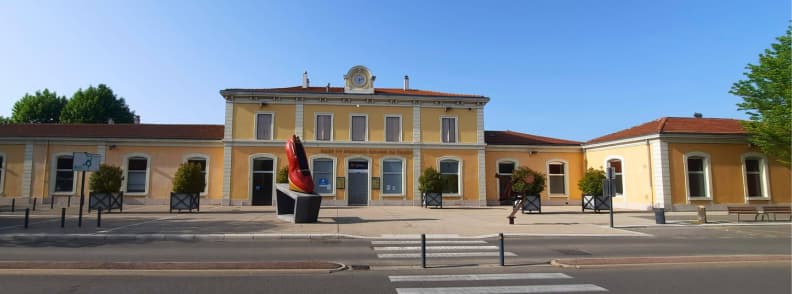
How to Get to Romans-sur-Isère
Romans sits just 20 minutes from Valence TGV station, connected by regular TER regional trains. This link makes it a perfect weekend escape for expats or travelers based in Lyon, Grenoble, or Avignon. You can also drive from Lyon in about 1 hour and 30 minutes or from Marseille in under 2 hours. Once in town, everything is walkable, from the Marques Avenue outlet village to the historic centre, Musée International de la Chaussure, and Cité de la Raviole.
Where to Park in Romans
If you’re driving, parking in Romans-sur-Isère is straightforward. The easiest free zones are around Marques Avenue and along Avenue Gambetta, a short walk from the centre. Paid spots are available near Place Jules Nadi and Place Maurice Faure, but they’re inexpensive compared to most French towns. Sundays are the best days to find parking quickly, as local traffic quiets down.
Accessibility in Romans-sur-Isère
Romans is relatively accessible, with flat central streets and compact attractions. Both the Shoe Museum and Cité de la Raviole are wheelchair-friendly, with ramps and accessible restrooms. The train station offers lift access to platforms, and most restaurants in the centre have seating suitable for guests with mobility needs.
Sundays in Romans
Sundays start slow in Romans, and that’s part of their charm. The morning market fills the streets until early afternoon, but most shops close on Sunday afternoons, leaving the town peaceful and walkable. This is the perfect time for a café break near the fountains at Place du Champ-de-Mars or a stroll along the riverbank before heading home.
Free Things to Do in Romans-sur-Isère
Traveling on a budget? Romans has plenty of free things to do. Visit the Collégiale Saint-Barnard to admire its Romanesque architecture, wander through the Jardin de la Cité de la Chaussure, or watch the sunset from the bridge over the Isère.
The first Sunday of each month, entry to the Musée International de la Chaussure is free. It’s the perfect opportunity to explore one of France’s most original museums without spending a cent.
Romans-sur-Isère Vacation Tip: Plan your visit around market days (Sunday and Thursday) for the liveliest atmosphere. Arrive by 10 AM, park near Marques Avenue, and walk into town. It’s the most relaxed way to experience Romans like a local.
Outdoor & Nature Activities near Romans-sur-Isère
Romans-sur-Isère is the gateway to nature in the Drôme. It’s surrounded by rivers, vineyards, and the foothills of the Vercors Regional Natural Park. Within minutes, you can swap cobbled streets for forest paths or cycle routes that trace the Isère valley. The landscapes here shift quickly, as lavender fields give way to limestone cliffs, and every village marks the start of a new trail. Whether you’re after a scenic hike, a gentle family walk, or a countryside ride, Romans is perfectly placed for slow outdoor travel.
Hiking, Cycling & Proximity to Vercors Park
Just 30 minutes from Romans, the Parc naturel régional du Vercors offers some of the most striking outdoor scenery in southeastern France. Trails start at Saint-Jean-en-Royans, La Chapelle-en-Vercors, or Pont-en-Royans, leading to waterfalls, gorges, and panoramic viewpoints. One of the most scenic drives in the region is the Route des Grands Goulets, where you can stop for short hikes through forested limestone cliffs.
Cyclists will love the Viarhona, the long-distance bike route that runs from Lake Geneva to the Mediterranean and passes through Romans-sur-Isère. From the city, you can follow the river north toward Tain-l’Hermitage, passing vineyards and hamlets, or head south toward Valence for a flatter ride. The Romans-sur-Isère Office de Tourisme offers maps and bike rentals, and many rural roads are well-signed for both amateur and experienced riders.
Romans-sur-Isère Travel Tip: For a half-day escape, drive or cycle to Saint-Nazaire-en-Royans. The view of the Aqueduc de Saint-Nazaire-en-Royans, mirrored in the water, makes a perfect picnic stop.
Family-Friendly Trails
Romans is also great for family walks and easy hikes, especially if you’re traveling with kids or just want a relaxed pace. The Bords de l’Isère walking path follows the river from Collégiale Saint-Barnard to the Pont Vieux, offering shaded benches, ducks, and views of the old town. South of Romans, the Bois des Ussiaux trail loops through woodland and open meadows, ideal for short strolls or picnic breaks.
For something more adventurous but still manageable, head to Le Vercors’ lower plateaus, where easy trails around La Chapelle-en-Vercors or Saint-Martin-en-Vercors reveal limestone cliffs and alpine pastures without steep climbs. Many of these routes are stroller-friendly and well-marked, making them perfect for expats with young families exploring the area.
Vercors Hiking Tip: Bring refillable bottles. Vercors springs offer some of the purest drinking water in France, and several village fountains along hiking routes are safe to use.
Best Day Trips from Romans-sur-Isère
Romans-sur-Isère makes a perfect base for discovering the wider Drôme region and the edge of the Vercors mountains. Its central location means you can switch between medieval villages, vineyards, and dramatic limestone landscapes in under an hour. For travelers and expats wanting to see more of southeastern France without constant hotel changes, these day trips are varied, scenic, and easy to organize.
Saint-Antoine-l’Abbaye, a Village of Stone & Silence
Just 40 minutes northwest of Romans, Saint-Antoine-l’Abbaye is officially ranked among the Plus Beaux Villages de France. The highlight is its Gothic abbey church, built between the thirteenth and fifteenth centuries, with carved doorways, stained glass, and cloisters that open onto the surrounding hills. The village itself feels timeless, with cobblestone lanes, medieval houses, and art galleries tucked into old cellars. Stop by the Musée de Saint-Antoine, which explores the role of the Hospitaller monks who once cured pilgrims suffering from ergotism, a disease known as “Saint Anthony’s Fire”. It’s one of the most peaceful places to see near Romans, perfect for slow travelers and history enthusiasts.
Drôme Travel Tip: Visit early or late in the day to enjoy the village before tour groups arrive, and have lunch at a terrace café overlooking the abbey.
Valence, for a Taste of the Rhône Valley
A short 20-minute train ride from Romans brings you to Valence, the capital of the Drôme. Known for its elegant boulevards, shady parks, and gourmet dining, Valence is both relaxed and cosmopolitan. The Maison Pic, run by chef Anne-Sophie Pic, France’s most awarded female chef, is here for those seeking a Michelin-star experience. For a simpler day, explore the old town, Saint-Apollinaire Cathedral, and Jouvet Park, one of the most beautiful green spaces in the Rhône Valley.
Valence is also a gateway to Côtes-du-Rhône wine routes and nearby vineyards like Tain-l’Hermitage, where wine tastings and chocolate pairings await. It’s a perfect balance between city comfort and rural charm, a top day trip from Romans-sur-Isère for culture and food lovers.
Visit Drôme Tip: Take the TER train for the best convenience. It’s quick, scenic, and drops you in the heart of Valence without parking stress. And you can enjoy the local wine this way.
Die & the Route du Vercors
Heading south through the Drôme valley, Die offers a completely different landscape. Surrounded by mountains, this small town is famous for Clairette de Die, a sparkling wine made from Muscat grapes. Visitors can tour local wineries for tastings, explore the Roman-era ramparts, and wander its narrow alleys full of artists and small cafés.
For nature lovers, the Route du Vercors between Pont-en-Royans, La Chapelle-en-Vercors, and Vassieux-en-Vercors provides one of the most scenic drives in France. Expect limestone cliffs, gorges, and viewpoints that open suddenly onto the Alps. It’s ideal for hiking, photography, or even motorcycling in the Drôme, thanks to its smooth, winding roads and breathtaking scenery.
Drôme Travel Advice: Bring layers. The Vercors plateau can be several degrees cooler than Romans, even in summer, but the views are worth every turn.
Other Easy Trips from Romans-sur-Isère
If you prefer quieter stops, explore Pérouges, a preserved medieval town to the north, or Crest, known for its towering stone keep and street markets. Closer to Romans-sur-Isère, Saint-Nazaire-en-Royans makes an easy half-day trip with its aqueduct and lakeside cafés.
From wine tastings to hiking trails, these day trips from Romans-sur-Isère show the Drôme at its best. It’s authentic, varied, and always within easy reach. Each destination feels different yet shares the same relaxed pace that defines life in this part of France.
Visit Romans-sur-Isère FAQs
Planning a trip to Romans-sur-Isère? Here are the most detailed answers to common questions about this historic town, designed for travelers and expats who want accurate, up-to-date, and insider information.
What is Romans-sur-Isère famous for?
Romans-sur-Isère is known as the shoe capital of France and for its centuries-old craftsmanship in luxury footwear. The town is also famous for its International Shoe Museum, Cité de la Chaussure, and culinary specialties like ravioles du Dauphiné (tiny cheese-filled pastas) and pogne de Romans, a sweet orange blossom brioche. Located in the Drôme department of southeastern France, Romans combines artisanal heritage, local gastronomy, and riverside charm, making it one of the region’s most authentic destinations.
What are must-see attractions in Romans-sur-Isère?
The top Romans-sur-Isère attractions include the International Shoe Museum, with 16,000 pairs tracing 4,000 years of footwear history, Cité de la Chaussure, a living workshop where artisans from brands like Clergerie and Jourdan still make shoes, Collégiale Saint-Barnard, a Romanesque-Gothic church dating back to 837, Cité de la Raviole, a museum dedicated to the region’s famous ravioles, Tour Jacquemart, the city’s medieval clock tower, Marques Avenue, a premium outlet village for shopping, and the Isère Riverwalk and Place Maurice Faure, perfect for cafés and markets.
What is the International Shoe Museum?
The International Shoe Museum (Musée International de la Chaussure) is one of France’s most original museums. Located inside the former Convent of the Visitation, it exhibits 4,000 years of shoe design and history. Highlights include royal footwear, early industrial models, and modern creations. It also explores how Romans became a global center of shoemaking innovation.
What are the operating hours for the Shoe Museum?
The International Shoe Museum is open Tuesday to Sunday, from 10 AM to 6 PM, and closed on Mondays. Entry is free on the first Sunday of every month. Seasonal temporary exhibitions are also hosted throughout the year.
Is Marques Avenue Romans worth visiting?
Yes, Marques Avenue Romans is worth visiting, especially for travelers who enjoy outlet shopping and French brands at discounted prices. Located in the former Caserne Bon, it features over 70 boutiques with well-known names in fashion, footwear, and home goods. Benefits include easy parking and central location, while drawbacks include crowds on weekends and an outdoor layout that can be hot in summer or cool in winter. It’s open Monday to Saturday, 10 AM-7 PM.
What historic buildings can I visit in Romans-sur-Isère?
Romans has an impressive concentration of historic architecture. Key landmarks include Collégiale Saint-Barnard, with its mix of Romanesque and Gothic styles and 14th-century murals, Tour Jacquemart, a surviving element of the medieval city walls, Couvent de la Visitation, now home to the Shoe Museum, and Maison du Mouton, one of the oldest timber-framed houses in the city. These sites are all walkable from the old town, making Romans ideal for a self-guided heritage walk.
What local food specialties are unique to the Drôme region?
Romans is at the heart of Drôme’s gastronomic heritage. Must-try local foods include Ravioles du Dauphiné, thin pasta squares filled with Comté cheese and herbs, Pogne de Romans, orange blossom brioche traditionally baked for Easter, Caillette, a local herb-flavoured pork terrine, Picodon goat cheese and Saint-Marcellin, both regional favorites, and wines from the Côtes du Rhône and Clairette de Die sparkling wine from the nearby Diois region.
Where to eat local food in Romans-sur-Isère?
For authentic local dining, try Le Dandy on Place Maurice Faure, known for seasonal dishes made from local produce, or La Villa Margot, an elegant restaurant facing Marques Avenue offering refined organic and gourmet cuisine. For traditional ravioles or pogne, head to Maison Pascalis and Pognes Mourier. Casual lunches and brunches are best at Le Jakadi, which serves hearty plates and local flavours.
Where can I buy Raviole de Romans?
You can buy Raviole de Romans fresh from producers in the historic centre or directly at La Cité de la Raviole, which offers museum tours and takeaway trays. Supermarkets in the Drôme, such as Intermarché and Carrefour, also stock authentic ravioles under the Label Rouge Raviole du Dauphiné. For visitors, ravioles can be purchased chilled and packed for transport, but they must stay refrigerated.
Is Romans-sur-Isère family-friendly?
Yes, Romans-sur-Isère is very family-friendly. The town’s compact layout, riverside parks, and open squares make it easy to explore with children. Kids love the fountains at Place du Champ-de-Mars, interactive displays at the Cité de la Raviole, and weekend markets full of treats. Family day trips to the Vercors mountains or Saint-Nazaire-en-Royans aqueduct add outdoor variety, and several local restaurants offer children’s menus and relaxed atmospheres.
Families visiting in summer should plan a Sunday morning at the market, followed by lunch in town and a splash in the fountains. It’s the perfect Romans day for all ages.
What events take place in Romans-sur-Isère?
Romans-sur-Isère hosts several events throughout the year that reflect its culture and love of good food. The biggest is the Fête de la Pogne et de la Raviole, held every June in the historic centre. For two days, the streets fill with food stalls, tastings, and cooking demonstrations celebrating the town’s two emblematic specialties. Summer brings night markets, open-air concerts, and craft fairs in the squares around Place Maurice Faure, while autumn focuses on regional harvests, wines, and truffles. In December, the Romans Christmas Market transforms the town into a festive village of wooden chalets and local artisans.
Best time to visit Romans-sur-Isère?
The best time to visit Romans-sur-Isère is from May to September, when the weather is warm, terraces are open, and the markets are full of seasonal produce. Spring and early summer are ideal for sightseeing and day trips into the Vercors mountains, while late summer offers vibrant festivals and extended daylight hours for evening walks. The warm air, long evenings, and easy-going pace make this the most enjoyable period to experience Romans like a local.
What is the cheapest time to visit Romans-sur-Isère?
The cheapest time to visit Romans-sur-Isère is during the late autumn and winter months, between November and March. Accommodation prices drop, and there are fewer visitors at the main attractions such as the International Shoe Museum and Cité de la Chaussure. Although some smaller shops close for holidays, it’s still a pleasant time for city walks and local dining, especially around Christmas when the market lights up the historic centre. Traveling midweek outside school holidays brings the best value.
Does Romans-sur-Isère have a TGV station?
Romans-sur-Isère does not have its own TGV station, but it’s well connected through Valence TGV, located about 20 minutes away. From there, frequent TER regional trains link Valence TGV to Romans-Bourg-de-Péage station, right in the city centre. This makes Romans easily accessible from major cities like Paris, Lyon, and Marseille, without needing to rent a car.
How far is Romans-sur-Isère from Valence?
Romans-sur-Isère is about 20 kilometres northeast of Valence, a journey that takes 20 minutes by train or 25 minutes by car via the D538 road. The route runs through open countryside and small villages, making it a pleasant drive or cycle for those exploring the Drôme.
How to get to Romans-sur-Isère from Valence?
The easiest way to reach Romans from Valence is by TER train, with departures every hour from Valence TGV or Valence Ville stations. The ride takes around 20 minutes and stops at Romans-Bourg-de-Péage, a short walk from the old town and attractions like Marques Avenue and the Collégiale Saint-Barnard. Travelers with cars can take the D538 or A49 motorway. Parking is free near Marques Avenue and inexpensive in the town centre.
Where to stay in Romans-sur-Isère?
Romans offers a mix of boutique apartments, hotels, and creative stays, making it ideal for both short visits and longer stays. The most unique option is BedinShop, which converts historic shopfronts into themed eco-apartments such as La Chaumière, Le Bouquiniste, and L’Apothicaire. Each space blends comfort with sustainability and a direct link to the town’s heritage. For travelers who prefer hotel amenities, properties near Place Jules Nadi or the Isère River provide central, walkable access to cafés, museums, and markets.
Where to stay near Marques Avenue Romans?
For visitors coming to shop or attend business meetings, La Villa Margot is the top choice. This elegant restaurant and guesthouse sits directly opposite Marques Avenue, in a nineteenth-century mansion surrounded by gardens. It offers peaceful rooms, gourmet dining, and easy parking. It’s ideal for travelers who want comfort close to the shopping area. Other nearby stays include small hotels and guesthouses within a five-minute walk, but La Villa Margot stands out for its style and quality.
What outdoor activities are available near Romans-sur-Isère?
Romans-sur-Isère is surrounded by natural landscapes perfect for outdoor activities. The Vercors Regional Natural Park, just 30 minutes away, offers hiking, cycling, and scenic drives through limestone gorges and forests. Families can enjoy the riverside walking paths along the Isère, or short nature trails near Saint-Nazaire-en-Royans, known for its aqueduct and lake views. Cyclists can follow the ViaRhôna, a major bike route linking Lake Geneva to the Mediterranean, which passes directly through Romans. For expats and slow travelers, these outdoor options make Romans a comfortable base for combining small-town life with easy access to nature.
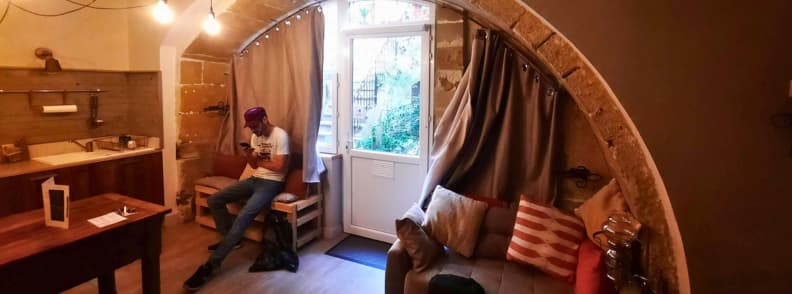
Why I’d Go Back to Romans-sur-Isère
What’s left of Mathieu’s Sequoia whisky sits on a shelf at home, its colour deepening with time. Every pour brings back that morning at the distillery, the scent of oak and grain, and the warmth of the owner explaining his craft. It reminds us of how Romans-sur-Isère rewards travelers who take their time.
What I loved most about visiting Romans-sur-Isère was the city’s authenticity, sustainability, and pride in craftsmanship. From the artisans at the Cité de la Chaussure to the young makers behind BedinShop, everyone we met cared about preserving and reinventing local traditions. There’s steady, thoughtful work that defines the best of slow travel in France.
I’d go back to visit the museums we missed, try the new bistros that have opened, and explore the hidden gems of the Drôme, especially the smaller villages scattered between Romans and the Vercors. There’s still more to taste, more to learn, and more to understand about how this corner of France continues to balance memory and modern life.
If you’re wondering why visit Romans-sur-Isère, it’s simple. It’s where history, craft, and everyday life still share the same table.
Find all Romans & Vercors stops on my Rexby guide.
About the Author

I’m Mirela Letailleur, the Romanian writer behind The Travel Bunny, an award-winning European travel blog focused on cultural, slow, and budget-smart travel. I live in the South of France and spend much of my time exploring small towns, local food, and authentic experiences that most travelers overlook. I write detailed, first-hand travel guides based on personal experience, from hiking volcanoes in La Réunion to finding the best hidden villages in Provence or the best cafés in Athens. My goal is to help travelers and expats see Europe through the lens of local life.
As a travel blogger, I combine storytelling with research to create my guides. My articles mix local insight, practical planning tips, and a sustainable travel approach shaped by years of exploring France, Greece, Belgium, and beyond. When I’m not writing, I’m either doing activities with my toddler, cooking, or exploring a new place with my family.
After planning your visit to Romans-sur-Isère, check out these France travel guides on The Travel Bunny
Enchanting Places in France. Best Hidden Gems Beyond Paris
Skiing in France. Expert Tips for an Unforgettable Experience in the French Alps
Complete Guide to Visiting Les Baux-de-Provence. Castle, Village & Hidden Gems

